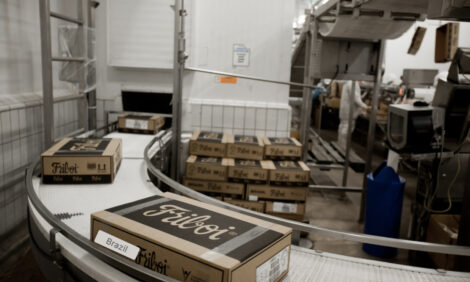



Tyson Sees Income Rise as Chicken Sales Increase
US - US meat and food processing giant Tyson Foods has seen net income rise from $778 million last year to $864 million in 2014.The rise in income was on the back of a rise in sale of more than $3 billion from $34.374 billion in 2013 to $37.58 billion.
However in the fourth quarter of the year the processor’s net income fell compared to 2013 from $261 million to $137 million while sales during the quarter rose from $8.894 billion to $10.105 billion.
"Two years ago, I told our team members, 'The turnaround is over; it's time to turn it on.' They did and the proof is in our second year in a row of record sales and earnings," said Donnie Smith , president and chief executive officer of Tyson Foods.
"This is an exciting time as we integrate Hillshire Brands and Tyson Foods and I believe that when we look back on this merger years from now, we'll see it as a watershed event," Mr Smith said,.
“We're setting higher expectations and anticipating more growth and increased profitability, specifically in the Chicken and Prepared Foods segments. In the long-term, our Chicken segment should generate a seven to nine per cent return on sales, although we expect fiscal 2015 to be particularly strong with a return of more than 10 per cent.
"Although it's still early in the process, I'm pleased with the progress we've made with the integration. We've identified the synergy targets, and now we're working to bring those dollars to the bottom line.
“We're very confident we'll meet the expected synergy amounts of $225 million or more for fiscal '15 and more than $500 million by the end of year three, and when we get there in fiscal 2017, we expect the Prepared Foods segment to earn a 10 to 12 per cent return on sales.
"Fiscal 2015 should be another great year and is already off to a strong start. We are projecting adjusted earnings for the year in the range of $3.30 to $3.40 per share, and as we look ahead to 2016, we see continued success and growth."
Chicken
Sales volume in the chicken sector grew as a result of stronger demand for chicken products and mix of rendered product sales.
Average sales price decreased as feed ingredient costs declined, partially offset by mix changes.
Operating income for the fourth quarter of fiscal 2014 was negatively impacted by rapidly rising costs of outside meat purchases. For the 12 months of fiscal 2014, operating income increased due to higher sales volume and lower feed ingredient costs, partially offset by decreased average sales price. Feed costs decreased $140 million and $600 million for the fourth quarter and 12 months of fiscal 2014, respectively.
Beef
Sales volume for beef decreased due to a reduction in live cattle processed. Average sales price increased due to lower domestic availability of beef products.
Operating income decreased for the fourth quarter of fiscal 2014 due to higher fed cattle costs and periods of reduced consumption of beef products, which made it difficult to pass along increased input costs, as well as lower sales volumes and increased operating costs.
For the 12 months of fiscal 2014, operating income increased due to improved operational execution and maximising our revenues relative to the rising live cattle markets, partially offset by increased operating costs.
Pork
Sales volume for pork fell slightly for the fourth quarter of fiscal 2014 as a result of balancing our supply with consumption and reduced exports. Sales volumes increased for the 12 months of fiscal 2014 due to better domestic demand for our pork products.
Average sales price increased due to lower total hog supplies, which resulted in higher input costs. Operating income increased as we maximized our revenues relative to live hog markets, partially attributable to operational and mix performance.
Prepared Foods
Tyson acquired and consolidated Hillshire Brands on 28 August.
Sales volume increased as a result of improved demand for Prepared Foods products and incremental volumes as a result of the acquisition of Hillshire Brands.
Average sales price increased due to price increases associated with higher input costs along with better product mix which was positively impacted incrementally by the acquisition of Hillshire Brands.
Legacy Prepared Foods operating income decreased as a result of higher raw material and other input costs of approximately $50 million and $210 million for the fourth quarter and 12 months of fiscal 2014, respectively.
Tyson said that because many of the sales contracts are formula based or shorter-term in nature, the company is able to offset rising input costs through pricing.
However, there is a lag time for price increases to take effect.
Additionally, operating income was reduced by $64 million and $113 million for the fourth quarter and 12 months of fiscal 2014, respectively, due to additional costs associated with the Prepared Foods improvement plan, Hillshire Brands post-closing results, purchase price accounting adjustments and ongoing costs related to a legacy Hillshire Brands plant fire.
International
Sales volume increased on international markets as the company grew businesses in Brazil and China.
Average sales price increased for the fourth quarter of fiscal 2014 due to a more favourable pricing environment in Mexico.
Average sales price decreased for the 12 months of fiscal 2014 due to poor export market conditions in Brazil, supply imbalances associated with weak demand in China and a less favourable pricing environment in Mexico.
Excluding the Brazil impairment and other related costs of $42 million, operating income in the fourth quarter was more favourable due to better market conditions in Mexico.
Operating income decreased in the 12 months of fiscal 2014 because of poor operational execution in Brazil, challenging market conditions in Brazil and China and additional costs incurred as we grew our International operation.
Outlook
In the 2015 financial year, the company expects overall domestic protein production – chicken, beef, pork and turkey – to increase by approximately one per cent from 2014 levels.
Grain supplies are expected to increase in 2015, which should result in lower input costs as well as decreased costs for cattle and hog producers.









